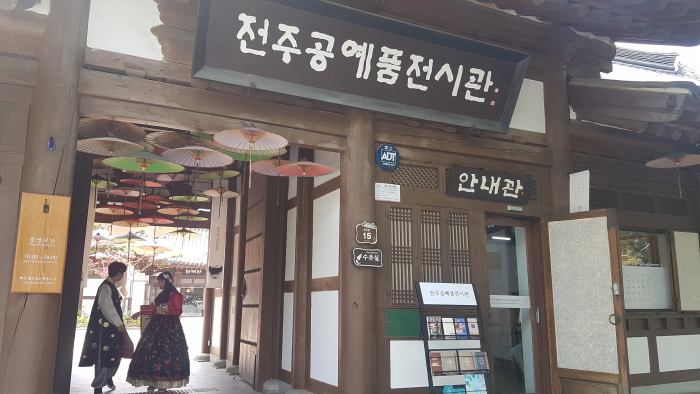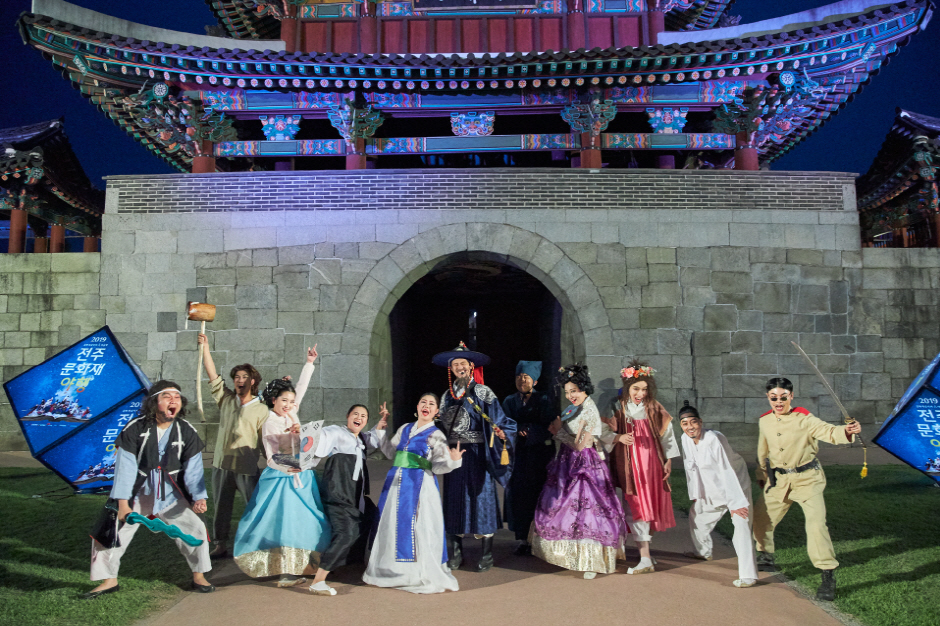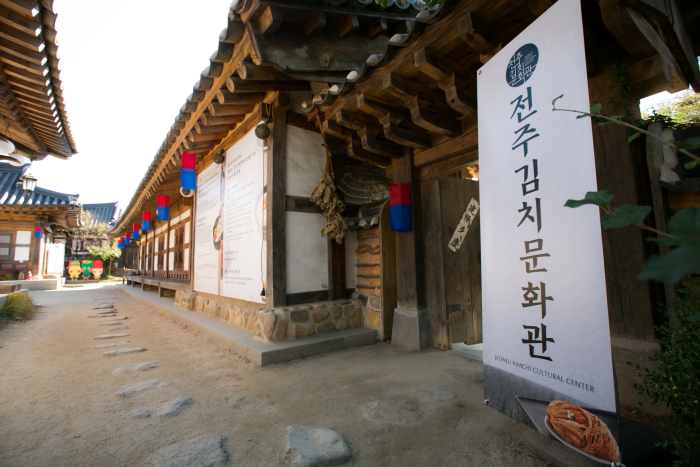Centre d'exposition de l’artisanat traditionnel de Jeonju (전주공예품전시관 전주명품관)
288.3M 4112 2024-04-07
15, Taejo-ro, Wansan-gu, Jeonju-si, Région Jeonbuk
+82-63-282-8886
Le centre d’exposition de l’artisanat traditionnel de Jeonju permet non seulement aux visiteurs de découvrir la beauté de l’artisanat traditionnel coréen, mais aussi de créer leurs propres créations. Le centre abrite un hall d’exposition, un hall spécial et un hall pour les activités. C’est dans le hall des activités que les visiteurs peuvent créer leurs propres pièces : feuilles de papier de riz, poterie, meunuiserie, broderie etc. Par ailleurs, dans le magasin d’artisanat il est possible d’acheter des pièces faites par des professionnels.
Voyage nocturne à Jeonju (전주 문화재야행)
289.3M 6653 2024-04-07
44, Taejo-ro, Wansan-gu, Jeonju-si, Région Jeonbuk
+82-63-232-9937
<Le voyage nocturne à Jeonju (Jeongjuyahaeng, 전주야행夜行)>
Ce programme vous permet d'apprécier les centaines de hanok du village de Jeonju et ce au clair de lune. Le voyage nocturne à Jeonju permet ainsi d'apprécier les principaux patrimoines culturels de la ville de Jeonju. Ce programme vous permet de découvrir les histoires cachées de la ville de Jeonju et son patrimoine culturel dans sa globalité.
Jeonggahanog [Korea Quality] / 정가한옥 [한국관광 품질인증]
304.1M 176 2024-04-07
78-3, Girin-daero, Wansan-gu, Jeonju-si, Région Jeonbuk
+82-10-9934-1300
Jeongga Hanok is a space where the traditional beauty of hanok and the modern comfort co-exists. The newly built Hanok is neat and pleasant. When you enter the small cobbled yard, the porch and the eaves will welcome you, and you’ll find that the rooms are filled with delicate wood fragrance. The interior is furnished with Korean cypress trees and red clay. In particular, the Cypress Tree room is all made of cypress trees, from the walls to the ceiling, making guests feel like they are lying in a forest. Maple Room and Ginkgo Tree Room, meanwhile, have attics.
Jeongga Hanok faces Jeonju Hanok Village with the Girin-daero in the middle. Hanok Village is just across the road. Major attractions such as Gyeonggijeon, Jeondong Catholic Cathedral, and Jeonjuhyanggyo Confucian School are all within walkable distance. Omokdae, which offers an unhindered view of Hanok Village, is located over the pedestrian overpass. Jaman Mural Village, famous for colorful mural and cozy cafes, is about 300 meters away and a great spot for selfie lovers.
Bu Yong Heon [Korea Quality] / 부용헌 [한국관광 품질인증]
310.9M 11203 2024-04-07
149-3, Hyanggyo-gil, Wansan-gu, Jeonju-si, Région Jeonbuk
+82-10-8646-0964
Buyongheon is located in Jeonju Hanok Village. Precisely speaking, Buyongheon is the very next door to Jeonju Hyanggyo (Confucian Temple and School). Across the alley are Jeonju Hyanggyo Culture Center and Wanpanbon Culture Center. If you walk a few more steps, you will reach Jeonju Hanbyeok Culture Center where you can see various performances and experience the culture and foods of Jeonju. Omokdae can be seen from the garden of Buyongheon. Across the Jeonjucheon Stream is the National Intangible Heritage Center.
The beginning of Buyongheon is deeply related with Jeonju Hyanggyo. In around 1935, the local bureaucrats lived around the Hyanggyo after building 12 houses one after another. Most of them came from rich families. These collective houses were called Buyong Houses, which meant rich houses. The name Buyongheon originated from Buyong Houses. The rooms of Buyongheon are composed of Toenmaru Bang, Daecheong Maru Bang, Large Daecheong Maru Bang and Big Sarangchae. The interior of the rooms looks neat with the beauty of blank space as they excluded unnecessary decorations. Carefully prepared breakfast is served upon request made in advance. Visitors can also experience traditional culture such as traditional etiquette education and Korean paper art.
In fall, the yellow leaves of the ginkgo tree in the garden of Jeonju Hyanggyo lights up the roof of Buyongheon. It is recommendable to walk along the Jeonjucheon Stream and take pictures of the colorful murals and the cafes in the Jaman Mural Village located on the left sie of the Hanok Village. It takes 15 minutes from Jeonju Station and 10 minutes from Jeonjuu Express Bus Terminal to Buyongheon by taxi.
Centre culturel de kimchi dans le village hanok de Jeonju (전주한옥마을 전주김치문화관)
313.9M 5262 2024-04-07
29, Eojin-gil, Wansan-gu, Jeonju-si, Région Jeonbuk
+82-63-287-6300
Le centre des expériences de vie traditionnelles de jeonju est un guest house situé dans le village de hanok de Jeonju. Les visiteurs peuvent y vivre une expérience unique de la vie en habitat traditionnel. Le centre était à l’origine une résidence de noble construite durant la dynastie Joseon (1392-1910) aujourd’hui reconstruite, elle accueille de nombreux visiteurs notamment des étrangers qui peuvent y découvrir le côté traditionnel de la Corée. L’habitat a perdu de son côté vetuste mais y a gagné en comfort. Les visiteurs peuvent s’amuser à découper le bois pour alimenter le système traditionnel de chauffage. Il s’agit du ondol, un système de chauffage qui irradie l’ensemble du sol par dessous. Les visiteurs dorment sur des petits matelas à même le sol où il est bon de se prélasser durant les journées froide d’hiver.
Dans ce guest house, les hôtes peuvent également apprendre des chansons traditionnelles, y prendre le thé, ou encore faire du vélo autour de la propriété. Les repas sont compris dans le prix de l’hébergement.
ONEWWAL[Korea Quality] / 오뉴월[한국관광 품질인증/Korea Quality]
318.1M 101 2024-04-07
51-5, Hyanggyo-gil, Wansan-gu, Jeonju-si, Région Jeonbuk
+82-10-3670-2581
Onyuwol is a “hanok” guesthouse located in Jeonju Hanok Village. It is attached to a café that combines hanok and modern interior design and has enjoyed considerable popularity via word-of-mouth among young travelers. There are five rooms in total, which are furnished comfortably like their namesakes (the months of May and June). The rooms bear the hallmark elegance of hanok, from their exposed rafters to red clay floors, white cotton beddings, and muslin curtains. The furnishings remained minimalist, with only bedding, a small TV, electric kettle, and a basket containing a towel, hairdryer, and a hand mirror. The sleep-themed room names show that they are furnished with a restful stay in mind. Opening the door brings guests to the view of the peaceful garden. Nabijam and Kkotjam rooms have small attics that add a layer of elegance, while only the Danjam room is furnished with a bed. All rooms are equipped with bathrooms. Guests can also enjoy a complimentary cup of Americano in the café, and international guests have access to English services. Furthermore, its location makes it a good starting point for visits to Jeonju’s major tourist sights, such as Jeonjuhyanggyo Local Confucian School, Gyeonggijeon Shrine, Omokdae Historical Site, or the alleyways of the historical city.
Cathédrale Jeondong (전주전동성당)
321.4M 7513 2024-04-08
51, Taejo-ro, Wansan-gu, Jeonju-si, Région Jeonbuk
Cette cathédrale bâtie en 1914 dans un style occidental est classé trésor national numéro 288. Il s’agit de la plus grande structure des deux provinces du Jeollado. La large façade en briques rouge ainsi que l’entrée et le clocher sont assez impressionnants en hiver. La voûte d’entrée rappelle le style byzantin, tandis que le petit clocher situé au centre ajoute un charme particulier. Malheureusement une partie de la cathédrale fut détruite dans un incendie en 1988.
La cathédrale de Jeondong a été construite en honneur des catholiques martyrs durant la dynastie Joseon. Le terrain fut acheté par le moine français Baudenet en 1891 (28ème année de règne du roi Gojong). On doit l'architecture du site au prêtre Poinel qui est aussi à l'original de la cathédrale de Myeongdong à Seoul.
Hakindang [Korea Quality] / 학인당 [한국관광 품질인증]
321.6M 12809 2024-04-08
45, Hyanggyo-gil, Wansan-gu, Jeonju-si, Région Jeonbuk
+82-63-284-9929
Hagindang was built by the same master builder and carpenter who took part in building the palaces. It's the oldest traditional Korean house in Jeonju Hanok Village and a city/province-designated Folklore Heritage No. 8 situated in Hyanggyo-gil. It has a tall gate in the middle of high walls on either side, behind which are a large front yard with a pond as well as trees surrounding the pond. The house behind this pond is in perfect harmony with the landscape. Right next to the tall gate are a detached building called “sarangchae” and an area designated for experiencing Korean tradition, including another detached building called “byeoldangchae” behind the main building named “Hagindang.” Bonchaedaegwan, which consists of three rooms named “Baekbeomjisil,” “Haegongjisil,” and “Injaejisil” exude elegance and grace The “sarangchae” is a stand-alone building with two rooms with an open living room called "daecheong" in between, making it a perfect place for an entire family to stay. The "byeoldangchae" has a total of three rooms, and the first one (Room No. 1) has a tea room with three windows made of thin wooden frames on three sides. Hagindang serves traditional Korean breakfast like the head family.
Hanokstory [Korea Quality] / 한옥이야기 [한국관광 품질인증]
323.5M 4018 2024-04-07
83-14, Eunhaeng-ro, Wansan-gu, Jeonju-si, Région Jeonbuk
+82-10-9203-1111, +82-10-4166-7799
Hanok Story in Hyanggyo-gil in Jeonju Hanok Village is a traditional Korean house built over 60 years ago and was recently renovated to serve as a guesthouse. Thus, it boasts of modern convenient facilities but preserves most of the features of a traditional Korean house, which was home to the guesthouse owner and his wife for over 35 years. The couple put old books, LPs, old movie posters, Korean lunch boxes, and old television on display in every corner of the house to create an old look and finish. In the yard is a 50-year-old persimmon tree that provides cool shade during the summer and delicious persimmons in the fall. All the old items in the house have a story to tell, and that's why the owner named his guesthouse "Hanok Story."
At the entrance of the house is a Korean phrase meaning “Enjoy the Five Blessings (longevity, wealth, health, love of virtue, and peaceful death) generation after generation with the energy of the sun, moon, and stars.” That’s why the rooms are named “Geumbit (Golden Light),” “Haetbit (Sunlight),” “Dalbit (Moonlight),” and “Byeolbit (Starlight).” The phrase is also engraved on top of the door to the "Haetbit Room." There are a total of seven guestrooms -- four in the main building and the "Solbit Room," "Deluxe Room No. 1," and "Deluxe Room No. 2." All the rooms are furnished with bathroom, TV, and air conditioner. Deluxe Room No. 2 has a kitchen for the guests to cook. There is a garden of sowbread, balloon vine, and hydrangea in the yard.
There is also a cafeteria made of cypress wood in the yard. The walls are covered with post-its left by the guests as well as musical instruments and dolls. It's where tea and breakfast are served. Homemade Korean breakfast is served for free. A tea class is also available during the weekend upon reservation.
Porte Pungnammun (전주 풍남문)
342.3M 5395 2024-04-08
1, Pungnammun3(sam)-gil, Wansan-gu, Jeonju-si, Région Jeonbuk
+82-63-287-6008
La porte Pungnammun a été construite dans le milieu du royaume de Jeoson (1768) et désignée trésor national no 308. Des 4 portes originales, c’est la seule qui reste (dans la partie sud de la ville). Sa structure a été partiellement détruite lors de l’invasion des forces étrangères de 1592 à 1598. Et a été reconstruite en 1978. Jungcheung et mullu sont au centre de la porte, épousant la forme de l’arche. Ces formes particulières forment le symbole du potentiel protecteur de la porte Pungnammun tout comme ils forment le symbole de sa grandeur.


![Jeonggahanog [Korea Quality] / 정가한옥 [한국관광 품질인증]](http://tong.visitkorea.or.kr/cms/resource/62/2594362_image2_1.jpg)
![Bu Yong Heon [Korea Quality] / 부용헌 [한국관광 품질인증]](http://tong.visitkorea.or.kr/cms/resource/94/2596794_image2_1.jpg)

![ONEWWAL[Korea Quality] / 오뉴월[한국관광 품질인증/Korea Quality]](http://tong.visitkorea.or.kr/cms/resource/97/2651897_image2_1.jpg)


![Hanokstory [Korea Quality] / 한옥이야기 [한국관광 품질인증]](http://tong.visitkorea.or.kr/cms/resource/20/2046320_image2_1.jpg)

 Français
Français
 한국어
한국어 English
English 日本語
日本語 中文(简体)
中文(简体) Deutsch
Deutsch Español
Español Русский
Русский